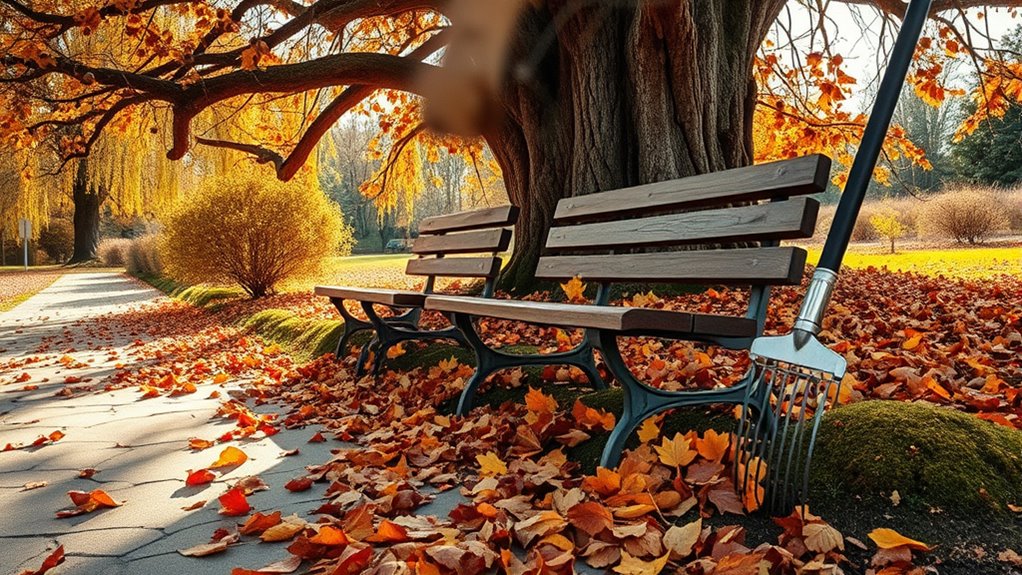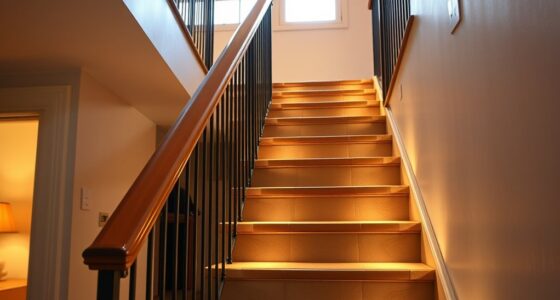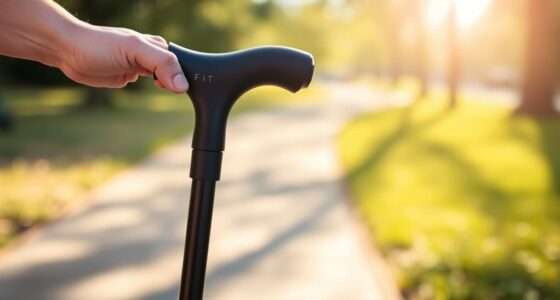To stay safe outside during fall, watch out for slippery leaves on walkways and shaded spots that stay damp longer. Wear shoes with good traction to prevent slips and be cautious on uneven pavement or ground. Use handrails or walking sticks for extra stability, and keep pathways well-lit to spot hazards clearly. Regularly clear leaves and inspect surfaces, so your outdoor experiences during fall remain safe — if you continue, you’ll discover more vital tips to protect yourself.
Key Takeaways
- Regularly clear leaves and debris from walkways, especially near shaded areas, to prevent slippery surfaces and hidden hazards.
- Wear footwear with good traction and use walking aids like sticks or handrails on uneven or slippery ground.
- Be cautious of wet leaves and dew early in the morning or after rain, which increase slipping risks.
- Inspect outdoor surfaces for cracks, holes, or uneven pavement, and report or repair hazards promptly.
- Improve pathway visibility with adequate lighting and avoid distractions like phone use when walking outside.

As the seasons change and outdoor activities increase, it’s important to be aware of fall hazards outside that can lead to serious injuries. One of the most common risks you’ll encounter during autumn is leaf litter. When leaves fall onto sidewalks, driveways, and pathways, they create a slippery surface that can easily cause you to lose your footing. Wet leaves, in particular, become slick and dangerous, especially when combined with dew or rain. If you’re walking or running through a leaf-covered area, take your time, watch your step, and avoid rushing. Raking or sweeping leaves regularly from walkways not only keeps your yard tidy but also reduces the risk of slipping unexpectedly. Be especially cautious around areas where leaves tend to collect, such as near trees or in shaded spots that stay damp longer. Additionally, leaf accumulation can hide uneven pavement and other hazards, making vigilance even more critical.
Another significant hazard to watch out for is uneven pavement. As the ground shifts and settles over time, sidewalks and walkways can develop cracks, holes, or uneven surfaces. These irregularities can be hard to see, especially if they’re concealed by leaf litter or debris. Walking across uneven pavement increases your chances of tripping or twisting an ankle, which can lead to serious injuries. Always pay attention to the condition of your walking surfaces before heading out, and avoid rushing through unfamiliar or poorly maintained areas. If you notice patches of cracked or uneven pavement, report them to the appropriate authorities or take steps to repair them if possible. When walking, try to keep your eyes focused ahead and watch for any irregularities in the ground—don’t just rely on your peripheral vision.
Additionally, be mindful of the changing conditions that make these hazards more dangerous. Leaves and uneven pavement are often more slippery after rain or early in the morning when dew is present. Your footwear also plays a vital role; sturdy shoes with good traction can help prevent slips and falls. If you’re walking in areas prone to leaf buildup or uneven surfaces, consider using a walking stick or handrail for extra stability. Remember to stay alert and avoid distractions like texting or looking at your phone while walking outside—these can cause you to miss potential hazards. Staying vigilant, especially during fall when these hazards are most prevalent, helps you avoid injuries and enjoy outdoor activities safely. Additionally, incorporating the use of home safety projectors with high contrast ratios and accurate color reproduction can help illuminate pathways and highlight potential hazards during low-light conditions, further reducing the risk of falls.
Frequently Asked Questions
How Can I Identify Hidden Tripping Hazards in My Yard?
To identify hidden dangers in your yard, walk around slowly and pay close attention to uneven surfaces, loose stones, or buried roots that could cause tripping. Check for overgrown plants hiding edges or hazards, and inspect walkways for cracks or gaps. Use a flashlight in shaded areas to spot hidden obstacles, and regularly maintain your yard to reduce yard hazards, ensuring you stay safe and avoid falls outdoors.
What Should I Do if I Encounter a Potentially Dangerous Wild Animal?
You might worry about provoking a wild animal, but understanding wild animal behavior helps you stay safe. If you encounter a potentially dangerous animal, keep a safe distance and avoid sudden movements. Back away slowly without turning your back or running, which could trigger aggressive behavior. Stay calm, speak softly, and give the animal space to leave. Remember, respecting their space keeps you safe and reduces the risk of conflict.
Are Certain Types of Outdoor Lighting More Effective for Safety?
You might find that certain outdoor lighting enhances safety better. Solar lighting is eco-friendly and easy to install, providing ample illumination without wiring. LED illumination offers bright, energy-efficient light that covers large areas effectively. Both options reduce tripping hazards and deter intruders. For peak safety, combine solar lights along pathways and LED fixtures around your yard, ensuring every outdoor space is well-lit and secure during nighttime hours.
How Can I Protect My Pets From Fall Hazards Outside?
Think of outdoor hazards as lurking shadows, ready to trip up your furry friends. To protect your pets from fall hazards outside, keep walkways clear of debris and uneven surfaces. Use pet-safe lighting to illuminate paths, and supervise outdoor playtime. Regularly check your yard for hidden dangers like loose fences or slippery patches. Prioritizing pet safety helps your animals enjoy the outdoors without risking falls or injuries.
What Are Best Practices for Outdoor Fall Cleanup to Prevent Accidents?
When doing outdoor fall cleanup, you should use proper equipment like gloves, sturdy rakes, and trash bags to stay safe. Always clear debris such as leaves, branches, and loose stones that could cause slips or trips. Dispose of debris promptly and properly to keep walkways clear. By staying attentive, using the right tools, and managing debris disposal, you prevent accidents and create a safer outdoor space during fall.
Conclusion
So, enjoy the crisp fall air and vibrant leaves, but don’t get too relaxed—after all, those beautiful autumn scenes hide hidden dangers. It’s ironic how the season that cheers us up can also trip us up if we’re not careful. Stay alert, watch your step, and embrace fall’s beauty safely. Because nothing says “fall fun” like avoiding a stumble just when you thought you had it all under control. Stay safe out there!









